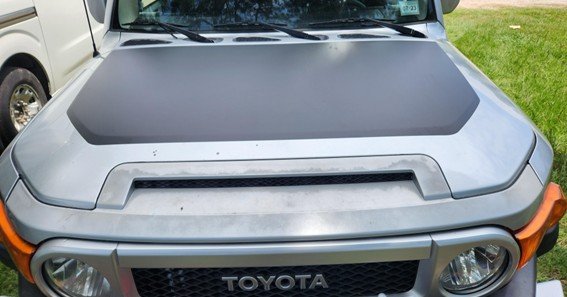The FJ Cruiser hood is more than just a metal panel; it’s a defining feature of Toyota’s iconic off-roader. Whether you appreciate its retro-inspired styling, need to replace a damaged hood, or want to upgrade to a performance option, understanding your FJ’s hood can help you maintain that classic look and functionality. In this blog, we’ll cover the hood’s design characteristics, customization choices, real-time availability, and top FAQs to guide you through every consideration.
1. Key Features of the FJ Cruiser Hood
-
Retro-Modern Aesthetic
- The FJ Cruiser hood takes cues from Toyota’s storied off-road lineage, evoking memories of the classic FJ40 while retaining a contemporary design.
- Its slightly raised center section and flat surfaces give the SUV a rugged, upright stance that appeals to adventure seekers.
-
Hood Scoop (Mostly Decorative)
- Some FJ Cruisers come with a non-functional hood scoop for added flair. While it doesn’t provide a performance boost, many owners love its aggressive look.
- Aftermarket options exist if you want to swap out the stock scoop or convert a plain hood to include one.
-
Durable Construction
- Toyota engineered the hood to withstand off-road conditions and flying debris.
- Proper maintenance, including checking for chips and rust spots, ensures it remains sturdy and visually appealing.
-
Material Variations
- Most OEM FJ Cruiser hoods are made from stamped steel.
- Aftermarket alternatives, such as fiberglass or carbon fiber, can reduce weight for performance-minded drivers or offer unique styling cues.
2. Real-Time Market Availability and Pricing
- OEM Parts
- You can find genuine Toyota hoods through dealerships, Toyota Parts Center, or major auto-parts retailers. Prices can range from $700 to $1,000 or more, depending on your location and shipping costs.
- Aftermarket Vendors
- Websites like CarParts.com and CARiD list aftermarket FJ Cruiser hoods, often priced lower than OEM alternatives. Keep in mind that fitment and finish can vary.
- Online Marketplaces
- As of recent checks on eBay Motors, used and aftermarket hoods are regularly available. Condition, color, and shipping distances affect pricing.
- Local Salvage Yards
- If you’re working on a tight budget, salvage yards can be a good source for used FJ Cruiser hoods. Inspect for dents, rust, or previous repairs before buying.
3. Customization and Upgrades
-
Wraps and Paint
- Vinyl wraps can add a pop of color or a matte finish without permanently altering the hood’s surface.
- For a custom paint job, ensure you use high-quality automotive paint and primer to guard against chipping and fading.
-
Functional Hood Scoops
- Some aftermarket manufacturers offer scoops designed to increase airflow to the engine bay. While the benefits on an FJ Cruiser can be minimal, they do add a unique touch.
-
Off-Road Protection
- Hood deflectors or bug shields can shield the hood’s front edge from stones and debris, prolonging its lifespan.
-
Hood Latches and Safety
- Upgraded hood latch kits can add style and security. For those in harsh off-roading environments, a more robust latch helps prevent accidental hood openings on bumpy trails.
4. Care and Maintenance Tips
- Regular Cleaning
- Wash away dirt and mud after off-road trips to prevent paint damage or rust.
- Touch-Up Paint
- Quickly address scratches or rock chips with factory-matched touch-up paint.
- Wax or Ceramic Coating
- A protective layer helps shield the paint from UV rays and contaminants.
- Periodic Inspection
- Check for dents, alignment issues, or rust formation. Early detection saves you from costlier repairs later.
- Secure Fasteners
- If you’ve installed an aftermarket scoop or accessories, ensure all nuts and bolts remain tight to avoid rattling or part loss.
Frequently Asked Questions (FAQs)
-
Q: Can I install a hood scoop on an FJ Cruiser hood that originally didn’t have one?
A: Yes, you can either purchase a hood with an integrated scoop or opt for aftermarket kits that attach to your existing hood. Make sure the kit is designed specifically for the FJ Cruiser to ensure a proper fit. -
Q: Are carbon fiber hoods worth it for off-road use?
A: Carbon fiber hoods are lighter and often look sleek, but they can be more expensive and sometimes less durable against heavy impacts compared to steel. If weight reduction is your priority, carbon fiber might be a good option. -
Q: Do hood wraps damage the paint underneath?
A: High-quality vinyl wraps typically don’t harm the paint if applied and removed correctly. They can also protect the paint from minor scratches and UV damage. -
Q: Will changing my FJ Cruiser hood affect my insurance?
A: Typically, cosmetic changes won’t impact your insurance. However, significant modifications or custom work should be disclosed to your insurance provider for clarity. -
Q: Should I buy a used OEM hood or a new aftermarket one?
A: This depends on your budget and preferences. A used OEM hood might fit perfectly but could have wear and tear. Aftermarket options can be cheaper or more customizable but might require minor adjustments for optimal fitment.
From its distinctive design to countless customization possibilities, the FJ Cruiser hood is a central part of this beloved off-road SUV’s character. Whether you choose an OEM replacement, an aftermarket upgrade, or a complete custom look, proper maintenance and fitment will ensure your FJ Cruiser stays ready for any adventure.










